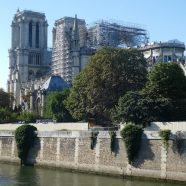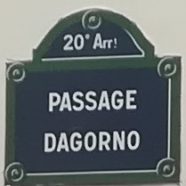Notre-Dame de Paris, a lead blast
Notre-Dame de Paris
Press release n°10
September 2017. The Direction Régionale des Affaires Culturelles (DRAC, Regional Directorate of Cultural Affairs) carries out a test campaign in Paris to assess the distribution of lead dust in the streets near historical monuments. This campaign proves that the Ministry of Culture was aware of the risks of lead dust emission and dispersal around historical monuments since at least 2017. This dissemination is caused by erosion, wear of the lead foils and other lead decorations and coatings on the inside and outside structure of the historic monuments. All 20 Parisian districts were included. 64 samples are lower than 1000 µg/m2 (or 1 mg), 27 go from 1000 to 3000 µg/m2, 6 from 3000 to 5000 µg/m2. Five go over a 5000 µg/m2 limit with a maximum of 21,175 µg/m2 near the Père Lachaise cemetery. It emerges from the statistical analysis of these results that the majority of Parisian streets were not contaminated by lead dust over the 1000 µg/m2 threshold before the Notre-Dame fire. This 1000 µg/m2 threshold taken as a reference by the study was set by the May 12, 2009 decree regarding the inspection of works with lead. The latter value must be respected when checking at the end of emergency work to eliminate the risk of lead exposure in a living area. The samples came from sites polluted by the lead from monuments as well from the urban heating system and the print of ancient metallurgic workshops and combustion from tetraethyl lead fuel. Despite the combination of all these sources, it is obvious that Paris’ streets before the Notre-Dame fire were not in the whole soiled by an extravagant, homogenous and irreversible lead pollution.
The lead makes itself at home
Notre-Dame de Paris, press release n°9
The entrance to the nursery school’s garden at the 17 rue de Verneuil in the 7th district is closed until further notice. There is a particular context. The garden is part of the annexes of the Hôtel de Sénecterre (24 rue de l’Université), which is a listed historical monument. Recently renovated by the Kering group, this building is home to the workshop and fashion shows of Saint Laurent.
On the initiative of Yves Saint Laurent’s firm, the schoolchildren were able to enjoy the formal garden, recreated from historical archives. It turns out that in several places, the garden is contaminated by a level of lead dusts well above admissible norms. As a conservation measure, Kering prohibits access to the garden and actively think about the necessary measures for its sanitation. This contamination of a recently opened and planted garden is an indicator of the urban pollution resulting from the Notre-Dame fire.
The scandal of the special needs education school Jacques Prévert on the rue du Pont de Lodi, Paris 6th district
Notre-Dame de Paris, press release n°8
Schoolchildren receive there an individualised education. They have difficulties with the learning process. Robin des Bois was informed Friday afternoon by a union representative that this specialised secondary high school, managed by City hall, would be closed until further notice because of a significant lead dusts contamination, especially in the playground (9695 µg/m2) and in the horticulture garden (42,913 µg/m2).
Nine interior premises are contaminated above the 70 µg/m2 threshold, particularly the refectory (873 µg/m2). Parents were not informed of this closure. No explanatory notice has been displayed on the closed doors. The 30 pupils as well as the teaching and support personnel are transferred to the Jacques Prévert secondary school on the rue Saint Benoît. This late closure and the lack of information is all the more regrettable given that these children already have learning difficulties and lead exposure can potentially make things worse. Along with teachers and support personnel, they were subjected to lead contamination between the 16th of April and summer holidays.
Notre-Dame de Paris, press release n°7
Notre-Dame de Paris, press release n°7
According to information we just received, the special needs education division (Section d’Enseignement Général et Professionnel Adapté, SEGPA) of the Jacques Prévert secondary school, on the rue du Pont de Lodi (Paris, 6th district), will not reopen due to lead contamination. The 30 pupils and the 11 teachers and educational support staff are transferred to the Jacques Prévert secondary school on the rue Saint-Benoît (6th district), which was decontaminated during the summer. The special needs education division is aimed at pupils with “serious and lasting learning difficulties” that follow an individualised educational background.
All the roads lead to school
Notre-Dame de Paris, press release n°6
28th August 2019 addendum : The information very recently circulated by City hall is not reliable. Only the three schools on the rue Saint-Benoît were subjected to a “treatment protocol” carried out by professionals and monitored by health and safety inspection. In the other schools, City hall mentions “treatment” of “ongoing works”, “intervention”, “cleaning”, “measures to be undertaken”. City hall does not clarify when these operations are going to be executed nor by whom. No decontamination report is available. As a reminder, contamination reports are still available on https://www.paris.fr/pages/incendie-de-notre-dame-l-essentiel-concernant-la-pollution-au-plomb-7028/ (at the bottom of the page).The lead samples and analyses in the polluted schools were carried out between the 13th of May and the 8th of August 2019, following the Notre-Dame fire. Primary schools and public secondary schools (collèges) are managed by City hall, public high schools (lycées) by the Île-de-France region. Private schools are managed by the OGEC (the management organisation for catholic teaching).
Cartography of the nurseries, nursery schools, primary schools, secondary schools and high schools polluted by lead.
Notre-Dame de Paris, press release n°5
Notre-Dame de Paris, press release n°5
A family whose 3 children are enrolled in the Sainte-Clotilde school, on the 77 rue de Grenelle in Paris, 7th district, summons the headteacher and the diocesan direction for catholic education in Paris for a summary procedure in order to have them check the lead surface concentration on the inner and external coverings and to make sure that the potential remedial measures are implemented before the start of the school year on the 2nd September 2019. The hearing is set for Wednesday 28th August at 10 a.m. at the Tribunal de Grande Instance de Paris, 17th district.
Notre-Dame de Paris, press release n°4
Notre-Dame de Paris, press release n°4
The Ministry of Culture, owner of Notre-Dame de Paris, has confirmed the shaky condition of the vault and flying buttresses of the cathedral. The scaffolding, which is covered with lead dusts and has until then withstood the collapse of the spire and the aftermath of the fire, is also under threat of downfall.
Therefore, Robin des Bois feels it is necessary to clarify the current prefectural decree on the imminent collapsing threat and to enforce, as part of this decree, a ban on all pedestrian traffic and all activities, especially business-related, on the rue du Cloître-Notre-Dame. A partial or complete collapse of the cathedral’s vault would cause other parts of the building to cave in, create an out-of-control cloud of contaminated dusts and a panic reaction, especially during the touristic peak hours.
Paris lead(er) instead of Paris-Plage
Notre-Dame de Paris, press release n°3
The lead is spinning around the cathedral. The dust flew away from their stony nests and the 4000 scaffolding tubes that leaned against the collapsed spire. Lead is everywhere and it is not displayed anywhere. The surroundings of the cathedral have become cult places of insanity, such as the street Cloître-Notre-Dame. The cathedral strengthening yard is suspended but in the street, the business continues. Lead micro and nano particles that fall from bells, statues and pinnacles are said to be blocked by a palisade. In Paris, since the evening of 15 April, there is a Chernobyl smell in the air in terms of information.













